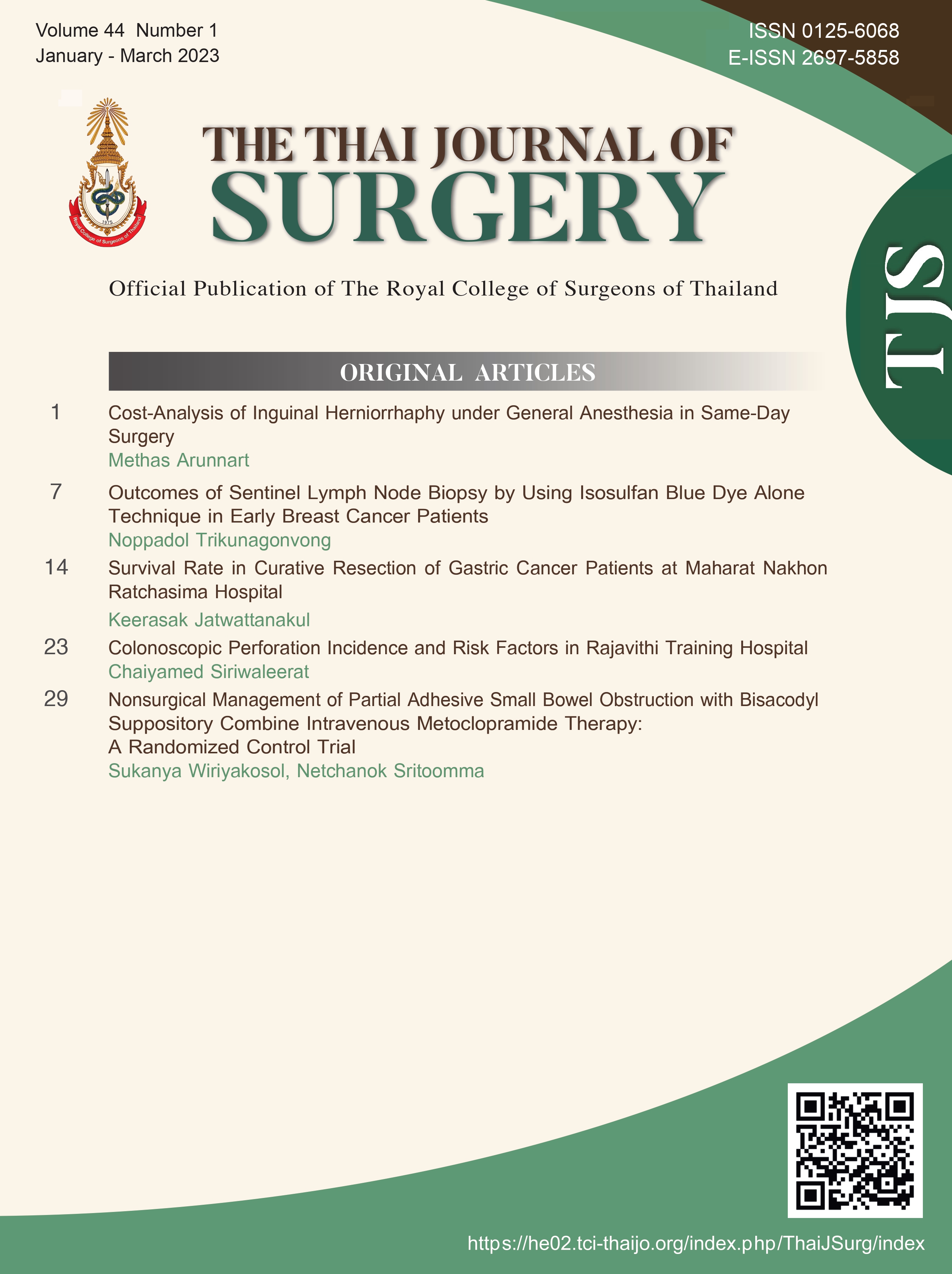Colonoscopic Perforation Incidence and Risk Factors in Rajavithi Training Hospital
Keywords:
Colonoscopic perforation, Risk factors, Incidence, Training center, ColonoscopeAbstract
Background: The colonoscope has become a standard tool for diagnosing and treating pathological diseases of the colon. Colonoscopic perforation is one of the serious consequences associated with colonoscopy, and as a result, it may result in a high rate of morbidity and mortality.
Objectives: This study aims to determine the incidence and risk factors associated with colonoscopic perforation in a training institution.
Methods: A retrospective review of medical records was performed for patients undergoing colonoscopy in Rajavithi Hospital between 2009 and 2019, total 10.057 patient. The patient’s demographic data, indication for colonoscopy, quality of bowel preparation, endoscopic procedure, perforation, and diagnostic were recorded.
Results: Between 2009 and 2019 12,239 colonoscope was performed and 2,182 colonoscopy was excluded. In total 0.71% (71/10,057) colonoscopic perforation was occurred. Multivariate logistic regression analysis reveals that previous gynecologic surgery (OR 41.1, p-value < 0.001, 95% CI 16.40-102.73), general anesthesia (OR 7.74, p-value 0.016, 95% CI 1.46-40.97), trainee (OR 20.74, p-value < 0.001, 95% CI 11.25-38.35) and polypectomy (OR 6.08, p-value < 0.001, 95% CI 3.15-11.70), EMR (OR 23.32, p-value < 0.001, 95% CI 6.02-90.41) and endoscopic subepithelial dissection (OR 89.99, p-value < 0.001, 95% CI 12.74-135.46) were significant.
Conclusion: Patients tend to have a higher colonoscopic perforation rate when they have a history of previous gynecological surgery or general anesthesia the colonoscopy to be performed by a trainee or polypectomy or endoscopic submucosal resection (EMR) or endoscopic submucosal dissection (ESD) to be performed. Even though we're aware of the risk factor, we must nevertheless handle each case with care and solely focus on high-risk populations in our practice.
References
Aras A, Oran E, Seyit H, et al. Colonoscopic Perforations, What is Our Experience in a Training Hospital? Surg Laparosc Endosc Percutan Tech. 2016;26:44-8.
de'Angelis N, Di Saverio S, Chiara O, et al. 2017 WSES Guidelines for the Management of Iatrogenic Colonoscopy Perforation. World J Emerg Surg. 2018;13:5.
Cai SL, Chen T, Yao LQ, et al. Management of Iatrogenic Colorectal Perforation: From Surgery to Endoscopy. World J Gastrointest Endosc. 2015;7:819-23.
Cha RR, Kim HJ, Lee CM, et al. Clinical Characteristics and Outcome of Iatrogenic Colonic Perforation Related to Diagnostic vs. Therapeutic Colonoscopy. Surg Endosc. 2022;36:5938-46.
Waye JD. Difficult Colonoscopy. Gastroenterol Hepatol (N Y). 2013;9:676-8.
Cooper GS, Kou TD, Rex DK. Complications Following Colonoscopy with Anesthesia Assistance: A Population-Based Analysis. JAMA Intern Med. 2013;173:551-6.
Wernli KJ, Brenner AT, Rutter CM, et al. Risks Associated with Anesthesia Services During Colonoscopy. Gastroenterology. 2016;150:888-94.
Chukmaitov A, Bradley CJ, Dahman B, et al. Association of Polypectomy Techniques, Endoscopist Volume, and Facility Type with Colonoscopy Complications. Gastrointest Endosc. 2013;77:436-46.
Laanani M, Coste J, Blotière PO, et al. Patient, Procedure, and Endoscopist Risk Factors for Perforation, Bleeding, and Splenic Injury after Colonoscopies. Clinical Gastroenterology and Hepatology. 2019;17:719-727.e13.
Wullstein C, Köppen M, Gross E. Laparoscopic Treatment of Colonic Perforations Related to Colonoscopy. Surg Endosc. 1999;13:484-7.
Reumkens A, Rondagh EJ, Bakker CM, et al. Post-Colonoscopy Complications: A Systematic Review, Time Trends, and Meta-Analysis of Population-Based Studies. Am J Gastroenterol. 2016;111:1092-101.
Derbyshire E, Hungin P, Nickerson C, et al. Colonoscopic Perforations in the English National Health Service Bowel Cancer Screening Programme. Endoscopy. 2018;50:861-70.
Taku K, Sano Y, Fu KI, et al. Iatrogenic Perforation Associated with Therapeutic Colonoscopy: A Multicenter Study in Japan. J Gastroenterol Hepatol. 2007;22:1409-14.
Iqbal CW, Cullinane DC, Schiller HJ, et al. Surgical Management and Outcomes of 165 Colonoscopic Perforations from a Single Institution. Arch Surg. 2008;143:701-6.
Downloads
Published
How to Cite
Issue
Section
License
Copyright (c) 2023 The Royal College of Surgeons of Thailand

This work is licensed under a Creative Commons Attribution-NonCommercial-NoDerivatives 4.0 International License.
Articles must be contributed solely to The Thai Journal of Surgery and when published become the property of the Royal College of Surgeons of Thailand. The Royal College of Surgeons of Thailand reserves copyright on all published materials and such materials may not be reproduced in any form without the written permission.



